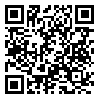Volume 4, Issue 3 (3 2006)
sjsph 2006, 4(3): 15-23 |
Back to browse issues page
Download citation:
BibTeX | RIS | EndNote | Medlars | ProCite | Reference Manager | RefWorks
Send citation to:



BibTeX | RIS | EndNote | Medlars | ProCite | Reference Manager | RefWorks
Send citation to:
Gilasi H, Holakouie Naieni K, Zafarghandi M, Mahmoudi M, Ghanei M, Soroush M, et al . Relationship between mustard gas and cancer in Iranian soldiers of imposed war in Isfahan Province: A Pilot Study. sjsph 2006; 4 (3) :15-23
URL: http://sjsph.tums.ac.ir/article-1-196-en.html
URL: http://sjsph.tums.ac.ir/article-1-196-en.html
H.R Gilasi 
 , K Holakouie Naieni
, K Holakouie Naieni 
 , M.R Zafarghandi *
, M.R Zafarghandi * 
 , M Mahmoudi
, M Mahmoudi 
 , M Ghanei
, M Ghanei 
 , M.R Soroush
, M.R Soroush 
 , A Dowlatyari
, A Dowlatyari 
 , A Ardalan
, A Ardalan 


 , K Holakouie Naieni
, K Holakouie Naieni 
 , M.R Zafarghandi *
, M.R Zafarghandi * 
 , M Mahmoudi
, M Mahmoudi 
 , M Ghanei
, M Ghanei 
 , M.R Soroush
, M.R Soroush 
 , A Dowlatyari
, A Dowlatyari 
 , A Ardalan
, A Ardalan 

Abstract: (16948 Views)
Background and Aim: In breach of all international conventions, Iraq frequently used chemical weapons against both military and civilian targets in its 8-year war with Iran. The most frequently used agent was sulfur mustard. The effects of mustard gas may be divided into early and late categories. Late lesions, due to the agent's mutagenic and carcinogenic potential, are mainly the results of its action on intracellular particles, probably nucleic acids. Although the occurrence of cancer has been proved following long-term exposure, the presence of a carcinogenic effect in acute, short-term contact is still in doubt.
Materials and Methods: To determine the relationship between cancer and acute exposure to mustard gas, a historical cohort study was carried out in Isfahan province, involving 500 chemically-injured soldiers with at least one episode of exposure to mustard gas. The incidence of cancer and the death rates in these subjects were compared with similar rates from i) 500 unexposed soldiers in the same area and ii) nationwide figures.
Results: All the subjects were male. The mean age in the exposed and unexposed groups were 41(±10.8), and 40(±7.6) years respectively. Within the exposed group, the mean age at first exposure was 24.1(±13) years the mean age at first injury in the unexposed group was 23(±11) years. Eighty-one percent of the cases lived in cities and 19% in rural areas. For 395 persons (84.5%) in the exposed group, education was at high school level or below. Within the same group, 481 subjects (96.2%) were married. Sixty-three people (12.6%) were servicemen and 366 (73.2%) had civilian jobs. Three cases of cancer were observed in those exposed to mustard gas. No cases occurred in the unexposed group. Ten people in exposed group and 7 in the unexposed group were dead at the time of the study. Relative risks for cancer and death were estimated at 4.02 (CI 95% = 0.45-36.1) and 1.44 (CI 95% = 0.54-3.81) respectively.
Conclusion: The results failed to show a statistically significant relationship between cancer incidence and acute exposure to sulfur mustard.
Materials and Methods: To determine the relationship between cancer and acute exposure to mustard gas, a historical cohort study was carried out in Isfahan province, involving 500 chemically-injured soldiers with at least one episode of exposure to mustard gas. The incidence of cancer and the death rates in these subjects were compared with similar rates from i) 500 unexposed soldiers in the same area and ii) nationwide figures.
Results: All the subjects were male. The mean age in the exposed and unexposed groups were 41(±10.8), and 40(±7.6) years respectively. Within the exposed group, the mean age at first exposure was 24.1(±13) years the mean age at first injury in the unexposed group was 23(±11) years. Eighty-one percent of the cases lived in cities and 19% in rural areas. For 395 persons (84.5%) in the exposed group, education was at high school level or below. Within the same group, 481 subjects (96.2%) were married. Sixty-three people (12.6%) were servicemen and 366 (73.2%) had civilian jobs. Three cases of cancer were observed in those exposed to mustard gas. No cases occurred in the unexposed group. Ten people in exposed group and 7 in the unexposed group were dead at the time of the study. Relative risks for cancer and death were estimated at 4.02 (CI 95% = 0.45-36.1) and 1.44 (CI 95% = 0.54-3.81) respectively.
Conclusion: The results failed to show a statistically significant relationship between cancer incidence and acute exposure to sulfur mustard.
Keywords: Neoplasms, Chemically warfare agent
Type of Study: Research |
Subject:
General
Received: 2005/05/31 | Accepted: 2006/01/22 | Published: 2013/08/11
Received: 2005/05/31 | Accepted: 2006/01/22 | Published: 2013/08/11
| Rights and permissions | |
 |
This work is licensed under a Creative Commons Attribution-NonCommercial 4.0 International License. |



